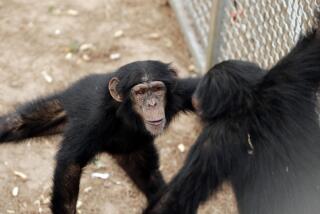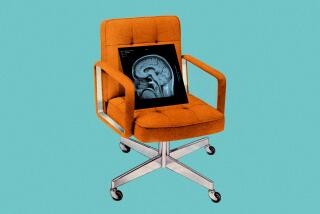Brain scans reveal that friends really are on the same wavelength
- Share via
What can an astronaut, baby sloths, a sentimental music video and an MRI scanner reveal about your friends? Quite a lot, a new study reveals.
Researchers put 42 business school students in an MRI machine and showed them a series of 14 videos. As they watched the clips, the scanner recorded the activity in their brains.
Those patterns could be used to predict which students were friends and which were merely classmates, according to a study published Tuesday in the journal Nature Communications.
“Neural similarity was associated with a dramatically increased likelihood of friendship,” the team from UCLA and Dartmouth College reported.
“These results suggest that we are exceptionally similar to our friends in how we perceive and respond to the world around us,” they added.
That might seem obvious to anyone who’s ever heard that “birds of a feather flock together.” But until now, no one had ever put that maxim to the test by examining the cognitive activity of friends in real time.
The researchers, led by UCLA social psychologist Carolyn Parkinson, started with an entire cohort of students from Dartmouth’s Tuck School of Business. All 279 of them were asked whether they were friends with each of their fellow students. (A “friend” was defined as someone you’d go out with for a drink, a meal, a movie or other “informal social activities.”)
If two students named each other, they were considered friends for the purposes of the study. Researchers used those responses to reconstruct the social network of the business school class.
In the next phase of the study, 42 of the students agreed to lie in a functional MRI scanner while they watched videos for 36 minutes.
The clips ranged in length from 88 seconds to more than 5 minutes, and were chosen to evoke a range of emotions in viewers.
For instance, a music video for the song “All I Want” was added to the reel because some people might consider it “sweet” while others would see it as “sappy,” the researchers explained. One of the clips presented a debate on whether college football should be banned; another featured a discussion about a speech by former President Obama.
The reel also included video from a gay wedding, a presentation by an astronaut on the International Space Station showing what happens when you wring out a washcloth in space, a documentary about a baby sloth sanctuary and highlights from a soccer match, among other things.
While the students watched, the scanner recorded the responses of 80 separate regions of their brains. Then the researchers compared the responses of each student with the responses of every other student.
The 42 students could be paired up in 861 distinct ways. Some of those pairs were friends, and some weren’t.
Sure enough, the responses of friend pairs were more alike than the responses of non-friend pairs. And the more similar their responses, the shorter the distance between them in the social network.
In statistical terms, for each one-unit increase in neural similarity, the odds that two people were friends increased by 47%.
Even when the researchers controlled for the similarities of people in each of the 861 pairs — including features like age, gender and nationality — the correlation between cognitive response and position in the social network remained.
That correlation was most clearly seen in areas of the brain involved in motivation, learning, attention, language processing and determining the mental states of others, to name a few examples.
“A more specific understanding of precisely which cognitive and emotional processes underlie these effects will likely require complementary follow-up studies,” the researchers wrote.
Parkinson and her colleagues also found that the brain responses alone could do a pretty good job of predicting whether two people were friends, mere acquaintances or total strangers.
All of the 861 pairs were divided into four categories of social distance. Friends had a distance of 1; a friend of a friend would have a distance of 2; a friend of a friend of a friend had a distance of 3; and pairs that were even further removed had a distance of 4 or more.
If a computer program was making random guesses about a pair’s social distance, it would guess right 25% of the time. But a program based on the brain responses correctly identified friends 48% of the time. It also recognized distance 2 relationships 39% of the time, distance 3 relationships 31% of the time, and distance 4 relationships 47% of the time, according to the study. (What’s more, when the program was wrong, it was usually only off by one category.)
The study results offer a new type of scientific proof that “people tend to be friends with individuals who see the world in a similar way,” the researchers concluded.
But the results don’t resolve this fundamental mystery about friendship: Do we become friends with people who already see the world the way we do, or do we come to see the world through our friends’ eyes?
Long-term studies will be needed to address those questions, but the study authors predict that the answer is: both.
Follow me on Twitter @LATkarenkaplan and “like” Los Angeles Times Science & Health on Facebook.
MORE IN SCIENCE
Sleep cycle troubles may be early sign of Alzheimer’s disease
This dinosaur from Egypt is a really big deal — in more ways than one
The search for life on other planets could get a boost from biosignatures







